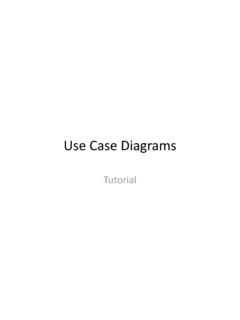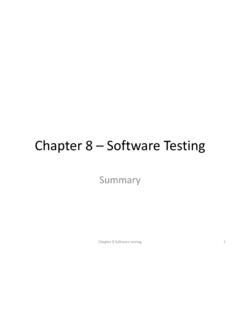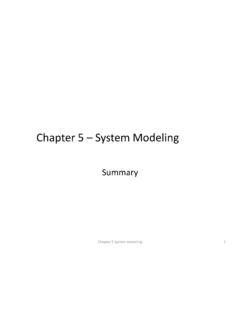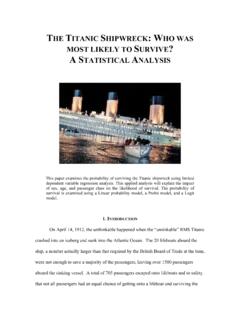Transcription of Classification of Titanic Passenger Data and Chances of ...
1 Proceedings of Student-Faculty Research Day, CSIS, Pace University, May 2nd, 2014 Classification of Titanic Passenger data and Chances of Surviving the Disaster data Mining with Weka and Kaggle Competition data Shawn Cicoria, John Sherlock, Manoj Muniswamaiah, and Lauren Clarke Seidenberg School of CSIS, Pace University, White Plains, New York Abstract While the Titanic disaster occurred just over 100 years ago, it still attracts researchers looking for understanding as to why some passengers survived while others perished. With the use of a modern data mining tools (Weka) and an available dataset we take a look at what factors or classifications of passengers have a persuasive relationship towards survival for passengers that took that fateful trip on April 10, 1912.
2 The analysis looks to identify characteristics of passengers - cabin class, age, and point of departure and that relationship to the chance of survival for the disaster. Keywords data mining; Titanic ; Classification ; kaggle; weka I. INTRODUCTION The Titanic was a ship disaster that on its maiden voyage sunk in the northern Atlantic on April 15, 1912, killing 1502 out of 2224 passengers and crew[2]. While there exists conclusions regarding the cause of the sinking, the analysis of the data on what impacted the survival of passengers continues to this date[2,3].
3 The approach taken is utilize a publically available data set from a web site known as Kaggle[4] and the Weka[5] data mining tool. We focused on decision tree based and cluster analysis after data review and normalization. A. Kaggle Predictive Modeling and Analytics Kaggle offers businesses and other entities crowd-sourcing of data mining, machine learning, and analysis. Sometimes offering prizes (for example there had been a $200,000 prize being offered from GE through Kaggle in a competition[1]). B. Weka - Waikato Environment for Knowledge Analysis The Weka tool provides a collection of machine learning and data mining tools.
4 Freely available built upon Java which allows it to run on platforms that support Java. It s maintained and supported primarily by researchers at the University of Waikato. II. data AND METHODOLOGY A. Sample data from Kaggle The following is a representation of the test dataset provided in a comma separated value (CSV) format from Kaggle and 891 rows of data (a subset of the entire Passenger manifest). The file structure with example rows is listed in the following 3 tables. B. data Normalization The dataset was modified to create nominal columns from some of the numeric columns in order to facilitate usage in Weka for Tree analysis and simple cluster analysis.
5 The modification is done to facilitate usage in Weka for tree analysis and simple cluster analysis. The following table identifies the conversions and other modifications. TABLE I. KAGGLE DATASET NORMALIZED data TYPES Field Modification Comment PassengerID Ignored Not needed Survived Converted to NO/YES Needed nominal identifier Pclass Removed -> created class column instead Needed nonminal identifier Class New Column Simple calculation based upon pclass Agegroup Formula based; some values not supplied. But ended up with 4 groups other than Unknown (Child, Adolescent, Adult, Old) Arbitrarily did the following: =IF(F2="", "Unk",IF(F2<10, "Child", IF(F2<20, "Adolescent", IF(F2<50, "Adult", "Old")))) Ecode Removed -> created class Embarked Needed nominal identifier Embarked New column that converted Ecode to the real name of the departure point for the Passenger C.
6 Normalized Analysis Dataset Upon conversion, the final dataset utilized for the analysis in the Weka tool is illustrated below with the first few rows shown. TABLE II. NORMALIZED DATASET EXAMPLE PassengerId Survived Pclass Class 1 No 3 3rd 2 Yes 1 1st 3 Yes 3 Erd TABLE III. NORMALIZED DATASET EXAMPLE (CONTINUED) Sex Age AgeGroup Ecode Embarked male 22 adult S Southhamptom Female 38 adult C Cherbourg Female 26 adult S Southhamtom D. Weka ARFF file Format The table is then converted and saved into the Weka Attribute-Relation File Format (ARFF). The ARFF file used is represented in appendix E.
7 The key characteristics of the ARFF file format in order to facilitate the data exploration in the Weka tool is the identification of the data types and within those fields the order of the nominal values. III. data ANALYSIS A. Decision Tree Classification Using Weka, we generated a J48[6] Tree ( implementation) which resulted in the classifier output represented in appendix G - J48 Classifier Output. The J48 Tree diagram shown in figure 2 below illustrates the Classification path that the data suggests. Fig. 1. J48 Classifer Diagram B. J48 Classifier - Initial Conclusions Based upon the outcome of the J48 analysis it was clear that the most significant association with regards to survival was related to Sex; in that just being Female was the most significant classifier.
8 We then reviewed the cluster analysis for further relationships. C. Simple K Means Cluster Analysis Clustering the data based upon classifications and use of clustering analysis simple associations may be understood from the data . While an association might be strong through this analysis, the true cause and effect cannot be concluded. D. Simple K Means Output For our cluster analysis, we chose the Simple K Means, just for simplicity. The Simple K Means text Output is included in appendix H. The visualizations are also shown in the following sections.
9 Using the cluster diagram we can visually analyze the clusters for relationships within the dataset. The strength of the Classification and clustering is shown visually as well as within the text output. This clustering relationship may be used to conclude that some relationship exists, but not cause-and-effect. E. Survived vs. Sex Quite dramatically visually we see that sex of the Passenger shows significant clustering around survival Chances . This had been also shown in the J48 tree. Figure 2 below illustrates the significant clustering of Sex vs.
10 Chance of survival. Whether this is anticipated or not is something that would require further corollary analysis within social sciences as to why one Sex may fare better in these traumatic situations. Fig. 2. Simple K Means Survived vs. Sex Classification F. Survived vs. Class Perhaps not surprisingly, cabin class had significant clustering with the lower tiered cabins showing significant weight towards non-survival. This is shown in figure 3 below with a fairly dominant clustering for those in 3rd class that did not survive.



















